

Matter of Britain. The Matter of Britain is a name given collectively to the body of medieval literature and legendary material associated with Great Britain, and sometimes Brittany, and the legendary kings and heroes associated with it, particularly King Arthur.
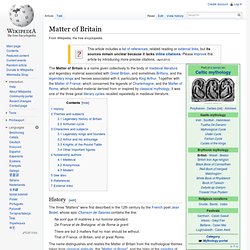
Together with the Matter of France, which concerned the legends of Charlemagne, and the Matter of Rome, which included material derived from or inspired by classical mythology, it was one of the three great literary cycles recalled repeatedly in medieval literature. History[edit] The three "Matters" were first described in the 12th century by the French poet Jean Bodel, whose epic Chanson de Saisnes contains the line: Ne sont que III matières à nul homme atandant, De France et de Bretaigne, et de Rome la grant.
There are but 3 matters that no man should be without, Irish mythology. Bunworth Banshee The mythology of pre-Christian Ireland did not entirely survive the conversion to Christianity.
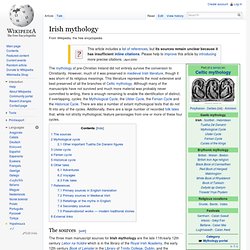
However, much of it was preserved in medieval Irish literature, though it was shorn of its religious meanings. Loch Ness Monster. The Loch Ness Monster is a cryptid, a creature whose existence has been suggested but is not discovered or documented by the scientific community.[3] It is reputedly a large unknown animal that inhabits Loch Ness in the Scottish Highlands.
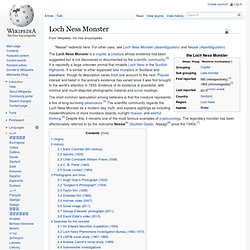
It is similar to other supposed lake monsters in Scotland and elsewhere, though its description varies from one account to the next. Popular interest and belief in the animal's existence has varied since it was first brought to the world's attention in 1933. Evidence of its existence is anecdotal, with minimal and much-disputed photographic material and sonar readings. Origins Loch Ness History. Danu (Irish goddess) In Irish mythology, Danu ([ˈdanu]; modern Irish Dana [ˈd̪ˠanˠə]) is the mother goddess of the Tuatha Dé Danann (Old Irish: "The peoples of the goddess Danu").
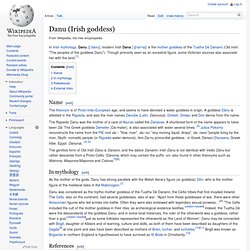
Though primarily seen as an ancestral figure, some Victorian sources also associate her with the land.[1] The genitive form of Old Irish Danu is Danann, and the dative Danainn. Irish Danu is not identical with Vedic Dānu but rather descends from a Proto-Celtic *Danona, which may contain the suffix -on- also found in other theonyms such as Matrona, Maqonos/Maponos and Catona.[5][6] Breton mythology. Breton mythology is the mythology or corpus of explanatory and herioc tales originating in Brittany, now in France.
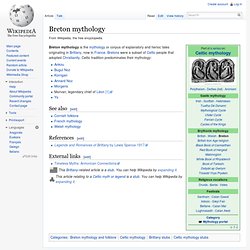
Bretons were a subset of Celtic people that adopted Christianity. Celtic tradition predominates their mythology: See also[edit] References[edit] Legends and Romances of Brittany by Lewis Spence 1917 External links[edit] Timeless Myths: Armorican Connections. Scottish mythology. Scottish mythology may refer to any of the mythologies of Scotland.
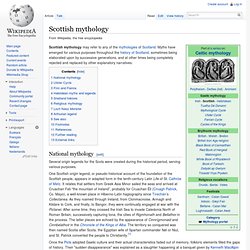
Myths have emerged for various purposes throughout the history of Scotland, sometimes being elaborated upon by successive generations, and at other times being completely rejected and replaced by other explanatory narratives. National mythology[edit] Several origin legends for the Scots were created during the historical period, serving various purposes. Welsh mythology. The prose stories from the White and Red Books are known as the Mabinogion, a title given to them by their first translator, Lady Charlotte Guest, and also used by subsequent translators.
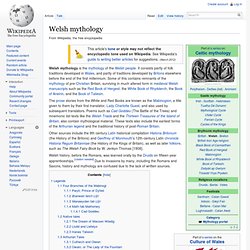
Hebridean mythology and folklore. The Inner and Outer Hebrides off the western coast of Scotland are made up of a great number of large and small islands.
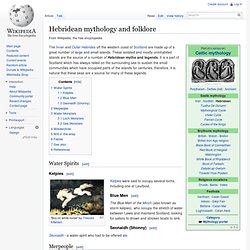
These isolated and mostly uninhabited islands are the source of a number of Hebridean myths and legends. It is a part of Scotland which has always relied on the surrounding sea to sustain the small communities which have occupied parts of the islands for centuries, therefore, it is natural that these seas are a source for many of these legends. Water Spirits[edit] Kelpies[edit] Kelpies were said to occupy several lochs, including one at Leurbost. Blue Men[edit] The Blue Men of the Minch (also known as storm kelpies), who occupy the stretch of water between Lewis and mainland Scotland, looking for sailors to drown and stricken boats to sink. Seonaidh (Shonny)[edit] Seonaidh - a water-spirit who had to be offered ale. Merpeople[edit] It has been claimed that there is a mermaid's grave in Benbecula, but the exact location is unknown. Will-o'-the-wisp. A will-o'-the-wisp /ˌwɪl ə ðə ˈwɪsp/ or ignis fatuus (/ˌɪɡnɨs ˈfætʃuːəs/; Medieval Latin: "foolish fire") are atmospheric ghost lights seen by travellers at night, especially over bogs, swamps or marshes.
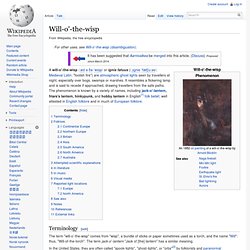
It resembles a flickering lamp and is said to recede if approached, drawing travellers from the safe paths. The phenomenon is known by a variety of names, including jack-o'-lantern, friars's lantern, hinkypunk, and hobby lantern in English[1] folk belief, well attested in English folklore and in much of European folklore. Terminology[edit] In the United States, they are often called "spook-lights", "ghost-lights", or "orbs"[2] by folklorists and paranormal enthusiasts.[3][4]